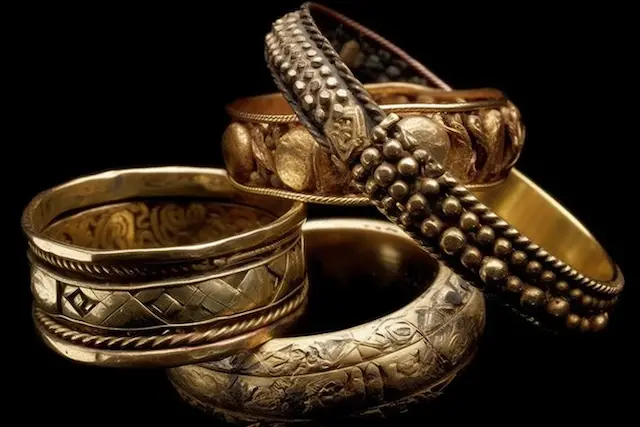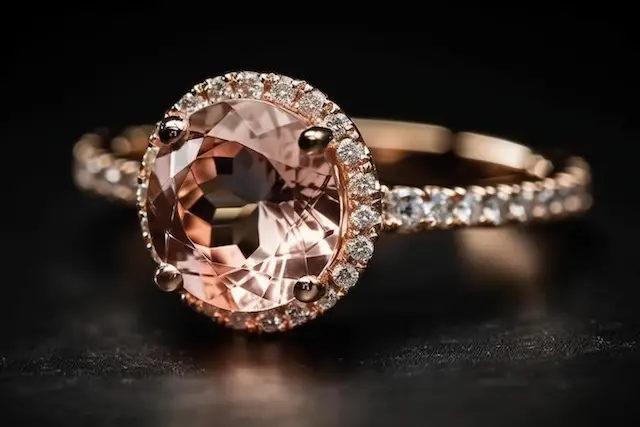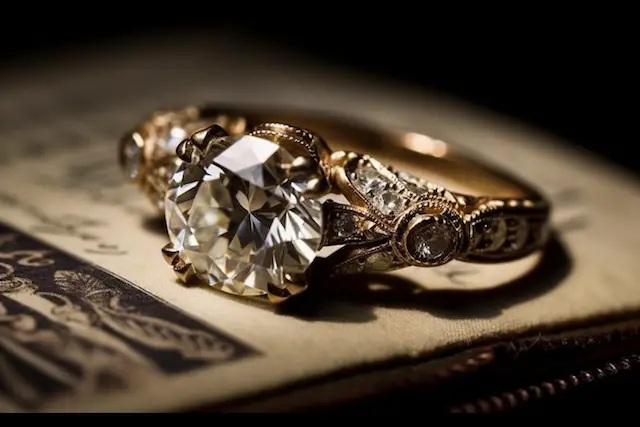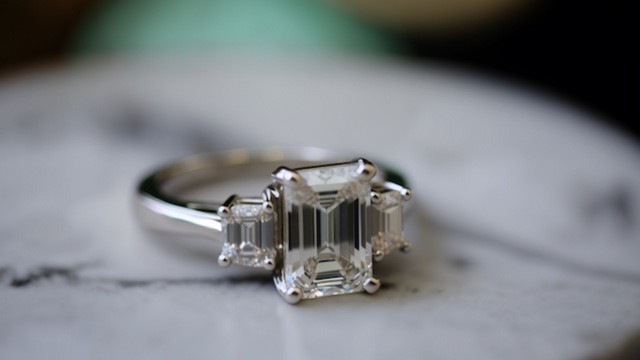History of Engagement Rings: Ancient Times to Modern Trends
Engagement rings are a beautiful symbol of love and commitment that have been around for centuries. From ancient Egypt and Rome to the famous De Beers campaign of the 1930s, the tradition of giving an engagement ring has seen many changes throughout history. Here’s a look at how engagement rings have evolved over time, from their humble beginnings to today’s modern trends.
Early History of Engagement Rings
Picture this: your partner gets down on one knee, holds out a little velvet box, and inside is a gleaming ring – a symbol of their love, devotion, and commitment to you. But have you ever wondered when did engagement rings start?
Ancient Egypt
The earliest known examples of engagement rings can be traced back to ancient Egypt. Egyptians believed that wearing a ring on the fourth finger of the left hand signified an eternal bond between two people, as this finger was believed to have a vein that ran directly to the heart. At first, these rings were simple braided reed bands, but they eventually evolved into more ornate metal rings decorated with symbols of love, such as hearts and birds – worn by both men and women!

Ancient Rome
Roman wives wore iron or ivory engagement rings attached to small keys in classical times to symbolize their husbands’ ownership. As time went on, these rings became more ornate and symbolic. Gimmel rings – rings made up of three interconnected bands – surged in popularity during this period and remain popular today.
Ancient Times, Middle Ages, Renaissance
While there may not be a specific quote that directly supports the historical use of engagement rings, the presence of engagement rings in ancient and medieval cultures is well-documented in literature and historical records.
Pliny the Elder wrote about engagement rings made of iron or gold in his first-century work “Naturalis Historia.”
In the 14th century, Geoffrey Chaucer’s poem “The Knight’s Tale” mentioned engagement rings as a symbol of marriage.
This idea of engagement rings was even further romanticized in Shakespeare’s plays, such as in “Romeo and Juliet” when Juliet says, “My bounty is as boundless as the sea; my love as deep: the more I give to thee, The more I have, for both are infinite.” (as a token of her love, Juliet gives the nurse a ring to give to Romeo)
In 1477, Archduke Maximilian of Austria took things one step further with his betrothed Mary of Burgundy by commissioning the first known diamond engagement ring. This started a trend among European nobility that spread throughout society by the 19th century.
Victorian Era
During the Victorian era, engagement ring symbolism began to change as the prevalence of diamonds grew. Queen Victoria’s husband, Prince Albert, presented her with an engagement ring featuring a diamond shaped like a serpent, a symbol of eternal love. This sparked a trend for diamond engagement rings among the wealthy, with diamonds becoming the standard for engagement ring stones.
The Rise Of Diamond Engagement Rings
Diamond engagement rings have been a cultural mainstay for centuries. But it was only in the late 19th century, when De Beers Mining Company was founded in South Africa diamonds became a popular choice for such a sweet gesture. The well-known and successful De Beers campaign of the 1930s to 1980s, which coined the phrase “A Diamond is Forever,” helped to make diamond rings a symbol of love and commitment.
The introduction of the Four Cs – cut, clarity, carat weight, and color – also played an important role in the rise of diamond engagement rings. These factors helped consumers comprehend the value of diamonds, made comparisons easier between stones, and allowed diamond rings to become a status symbol based on size and quality.
Today, diamond rings remain an integral part of our culture as we celebrate this timeless symbol of love and devotion every time two people decide to get engaged.
Modern Trends in Engagement Rings
Engagement rings continued to evolve throughout the years, with different styles coming in and out of fashion. In the 1920s, for example, the Art Deco movement influenced engagement ring designs with geometric shapes and streamlined designs.
The 1950s saw the rise of the halo-style engagement ring, where a central diamond is surrounded by smaller diamonds, enhancing the overall sparkle of the ring. Today, engagement rings come in all shapes, sizes, and styles, from classic solitaire to unique, personalized designs.
Alternative Gemstones
While diamonds have always been the traditional choice, more and more couples opt for alternative gemstones to add a unique touch to their rings.
- Sapphires: a popular alternative gemstone is a sapphire. Available in a wide range of colors, blue sapphire is the most common choice for engagement rings. Not only are sapphires visually stunning, but they also boast a high level of durability, with a hardness rating of 9 on the Mohs scale, making them ideal for everyday wear.

- Morganite: trending gemstone is morganite. This pink-orange-hued, salmon-like- color gem has gained popularity in recent years due to its romantic and delicate tint. While it may not be as durable as a diamond or sapphire, with a hardness rating of 7.5-8 on the Mohs scale, morganite can still withstand daily wear.
- Moissanite: For those who desire a diamond-like look without breaking the bank, moissanite may be the perfect alternative. As a lab-created gemstone, moissanite is significantly less expensive than a diamond yet has a similar sparkle and shine. In addition, with a hardness rating of 9.25 on the Mohs scale, it’s even more durable than a diamond.
Customization and Personalization
Customization and personalization are also growing trends in the world of engagement rings. Some popular ways to do this include:
- Engraving: couples choose to engrave special messages or dates inside their rings,
- Mixed metals: others are mixing metals such as rose gold and white gold for a unique touch.
- Stacking: Stacking rings have also become popular, allowing for more customization and personalization.
Overall, it’s clear that modern engagement ring trends are all about making the ring unique and personal to the couple. Whether through alternative gemstones or customization, couples are looking for ways to make their rings stand out and express their individuality.

Cultural Significance of Engagement Rings
Engagement Ring Traditions Around the World
In some parts of the world, engagement rings have a long and storied history. In India, for instance, grooms give their brides a mangal sutra necklace to symbolize their commitment during the engagement ceremony. Jewels such as diamonds are not involved in this ritual. African traditions also involve jewelry; grooms may present the bride with cowrie shells or kola nuts instead.
In many Western cultures, on the other hand, diamond engagement rings are trendy – they have become a modern-day symbol of love and commitment. Even though diamonds were not always part of the equation, they play a central role in engagement culture these days. Aside from diamonds, many couples opt for more unique designs that include different stones and precious metals to reflect their personal tastes and styles.
Overall, there are various customs around presenting and wearing engagement rings throughout different cultures around the world – each one unique and significant in its own way.
The Evolution of Engagement Ring Symbolism
Engagement rings have a long and complex history that dates back to ancient Rome.
While the tradition of diamond engagement rings might be one of the most well-known symbols of marriage today, its symbolism has evolved over time.
In recent years, couples have chosen to design their engagement rings or opt for unconventional styles to reflect their unique personalities and relationships better. This leads to a shift in the symbolism attached to engagement rings; they are now seen as a symbol of love rather than ownership.
Many couples are also choosing lab-grown diamonds and alternative stones, such as moissanite and sapphires, in order to express their love while still being mindful of ethical values and budget constraints.
With these changing ideas comes a more personal meaning for each couple, as an engagement ring is no longer just viewed as a symbol of love but also as an emblem of the journey taken together.
As we move into the future, couples will continue to redefine what their engagement rings mean to them, resulting in ever-evolving symbolism surrounding these special tokens of commitment.
The Dark History Of Engagement Rings
There’s a dark history behind the glitter and glamour that many of us are unaware of. As you prepare to say “yes” to your forever love, it’s important to understand the origins of the engagement ring and the questionable practices that have been associated with it over the years.
- Blood Diamonds: The diamond industry has long been associated with unethical practices, particularly when it comes to “blood diamonds.” These are diamonds that are sourced from war-torn countries where mining practices are often unsafe, and workers are exploited. If your engagement ring features a diamond, it’s important to ensure that it has been ethically sourced. Look for certifications such as the Kimberley Process Certification Scheme and ask your jeweler about the origin of the diamond.
- Propaganda and Marketing: The tradition of giving a diamond engagement ring as a symbol of love and commitment is a relatively modern one – it only gained popularity in the 19th century. The concept of a diamond ring was so successful that even today, many couples believe that an engagement ring must feature a diamond to be considered legitimate.
- Financial Pressure: The expectation that a man must spend a significant amount of money on an engagement ring can cause financial strain, particularly for those who are just starting in their careers or facing other financial obligations. The pressure to conform to societal expectations may lead to couples overspending on an engagement ring – an expense that could be put towards other priorities such as a home, travel, or savings. As you plan for your engagement, take into consideration your financial situation and create a budget that is right for you.
- Gender Viewpoints and Criticisms: Some critics argue that the tradition of giving an engagement ring is deeply rooted in patriarchal ideals. The notion that a woman must be “given away” by her father and then “claimed” by her husband through the exchange of a ring perpetuates the idea that women are possessions rather than equal partners in a committed relationship. Additionally, the idea that the size and value of the ring is a symbol of a man’s love and commitment can reinforce stereotypes about gender roles.
- Environmental Impact: The process of mining gold and other precious materials used in engagement rings can have significant environmental consequences. Mining can lead to deforestation, soil erosion, water pollution, and other negative effects. Consider choosing a lab-grown stone or a metal that is recycled to lessen your impact on the environment.
Additional Sources:
GIA: History of Engagement Ring
The New York Times: There’s a Ring of History to Diamond Betrothals


